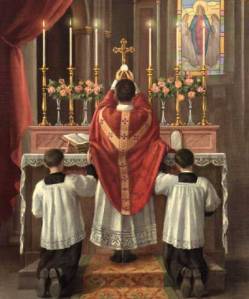 I was poking around the web, as one does, on a lazy day and came across a blog run by Meg Hunter-Kilmor called Pierced Hands. It was interesting as she had been to an Ordinariate Mass and found it both different from, and similar to, the Novus Ordo. Meg’s understanding of where the Ordinariate Rite fits is a good one, and one I thought I would share.
I was poking around the web, as one does, on a lazy day and came across a blog run by Meg Hunter-Kilmor called Pierced Hands. It was interesting as she had been to an Ordinariate Mass and found it both different from, and similar to, the Novus Ordo. Meg’s understanding of where the Ordinariate Rite fits is a good one, and one I thought I would share.
…the Anglican use Mass celebrated by the Ordinariate is not a rite distinct from the Roman rite the way that the Melkite or Ruthenian is…, the Anglican use is a version of the Roman rite. Because it’s not a distinct rite, it feels very similar to the Novus Ordo Mass that you’re used to attending every Sunday. It’s generally the same shape and many of the words are the same or similar. Eastern rite liturgies, on the other hand, can be dramatically different. I was once 20 minutes into a Ruthenian Mass before I realized that Mass had started!
Because it’s not a different rite, members of the Ordinariate don’t have any different rules from other Roman Catholics. Priests of the Ordinariate1are permitted to be married if they had previously been CofE priests, but the norm will not be for married men to be ordained. Even those who have converted have to get permission from the pope to be dispensed of the obligation of celibacy. They use the same lectionary, a very similar liturgical calendar, and the sameCode of Canon Law (as opposed to the Code of Canons of the Eastern Churches). What’s different is the liturgy, as I’ll explain below, and the fact that it’s possible through the Ordinariate for entire Anglican parishes to convert to Catholicism, as was the case this past Saturday with the Anglican Cathedral of the Incarnation. Although there have been many difficulties because of red tape and property ownership, a number of entire Anglican parishes have already come over to Rome, maintaining their traditions and community while receiving the fullness of the Truth.
The idea is not to establish a new rite in the Church but to serve the needs of people who are so accustomed to lofty, sacral language in their liturgy, who cherish their roots in 16th century English Catholicism, and who may have lived for 60 years in a parish of 300 souls, a community much smaller than your average Catholic parish
You can read the rest of the post here.
